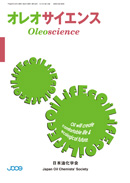All issues

Volume 3, Issue 11
Displaying 1-3 of 3 articles from this issue
- |<
- <
- 1
- >
- >|
-
An Application to Rigidity MeasurementHiroshi FRUSAWA, Kohzo ITO2003Volume 3Issue 11 Pages 583-589,581
Published: November 01, 2003
Released on J-STAGE: June 01, 2013
JOURNAL FREE ACCESSThe lipid nanotube can provide intriguing hydrophilic internal and external surfaces unlike carbon nanotubes and therefore they have unique potentialities not only as cytomimetic tubules but also as hollow nano-spaces for chemical reactions, transferring biomolecules and so on. Here we introduce two types of manipulation techniques. One is to exploit the micromanipulator, which enables us to align the single lipid nanotube on a glass plate in an arbitrary direction simply by microextruding the aqueous dispersion. Our manipulation methodology is promising to open up fascinating possibilities of lipid nanotubes; for example, a nano-needle could be realized by extruding half of the single nanotube and fixing it at the tip of micro-needle. The other technique is to use the optical tweezers by which a single nanotube can be bent. When the laser beam is switched off after some bending occurs, the bow-shaped nanotube starts to relax to its initial straight form. From the relaxation time, we found the Young's modulus similar to those of microtubles. Namely the lipid nanotube could be a good candidate for a cytomimetic tubule. We also investigate the temperature dependence of the flexural rigidity, suggesting that frozen lipids melt to some extent before the transition temperature between tube and vesicle form.View full abstractDownload PDF (2754K) -
Formation of Cuplike VesiclesYukio SUEZAKI2003Volume 3Issue 11 Pages 591-597,581
Published: November 01, 2003
Released on J-STAGE: June 01, 2013
JOURNAL FREE ACCESSIn the mixture of lipid and small amount of protein (talin) aqueous solution, cuplike vesicles were formed, in which talin was adsorbed at the periphery of cuplike vesicles. A statistical mechanical analysis was made to explain the observed concentration dependence of the shape of cuplike vesicles. It was made clear the following facts : the adsorption isotherm of talin to the periphery of cup determines the line tension of the cuplike vesicle and the mechanical balance of line tension and the bending elasticity of the lipid membrane determines the shape of the cuplike vesicle.
So far, lipid and bile salt mixture has been studied from the physiological and medical point of view. The researchers have long believed that the aggregates are disc like vesicle and/or spherical vesicle. As the size of the aggregates of this system is less than one micron, they cannot visually be observed. As an extension of the theory on the lipid and talin system, I theoretically predicted that cuplike vesicle could be one of aggregate forms of lipid and bile salt system either.View full abstractDownload PDF (2128K) -
Jun YAMAMOTO, Isa NISHIYAMA, Teruki NIORI, Hiroshi YOKOYAMA2003Volume 3Issue 11 Pages 599-607,582
Published: November 01, 2003
Released on J-STAGE: June 01, 2013
JOURNAL FREE ACCESSRecently, many new organic thermotropic liquid crystal materials are intensively improved under industrial research for high resolution flat-panel displays or photonic devices. On the other hand, we can find easily so many lyotropic liquid crystal phases in the biological systems, such as tissues, brains, neural networks etc. So, it is no doubt that the liquid crystalline state plays intrinsic roles on the biological system. Besides the genome technology gives us the only information on the memory data of the biological system, we have no knowledge on its “architecture”.
On the other hand, conventional liquid crystal displays are working by simple mechanism on the homogenous ground state of the liquid crystals. However, incompatibility introduced into the liquid crystalline order can produce the apparent elastic long-range interaction between incompatibilities due to the spatial distortion of the liquid crystalline order. Thus, we can model and construct the artificial self-organized huge stratified system. This is so called nano-structured liquid crystal system. In fact, the biological membrane was made by “heterogeneous” system, which has so many impurities, such as cholesterol, protein, DNA etc. We believe that the nano-structured liquid crystal systems are closest fundamental model of the architecture of biological systems.View full abstractDownload PDF (2236K)
- |<
- <
- 1
- >
- >|